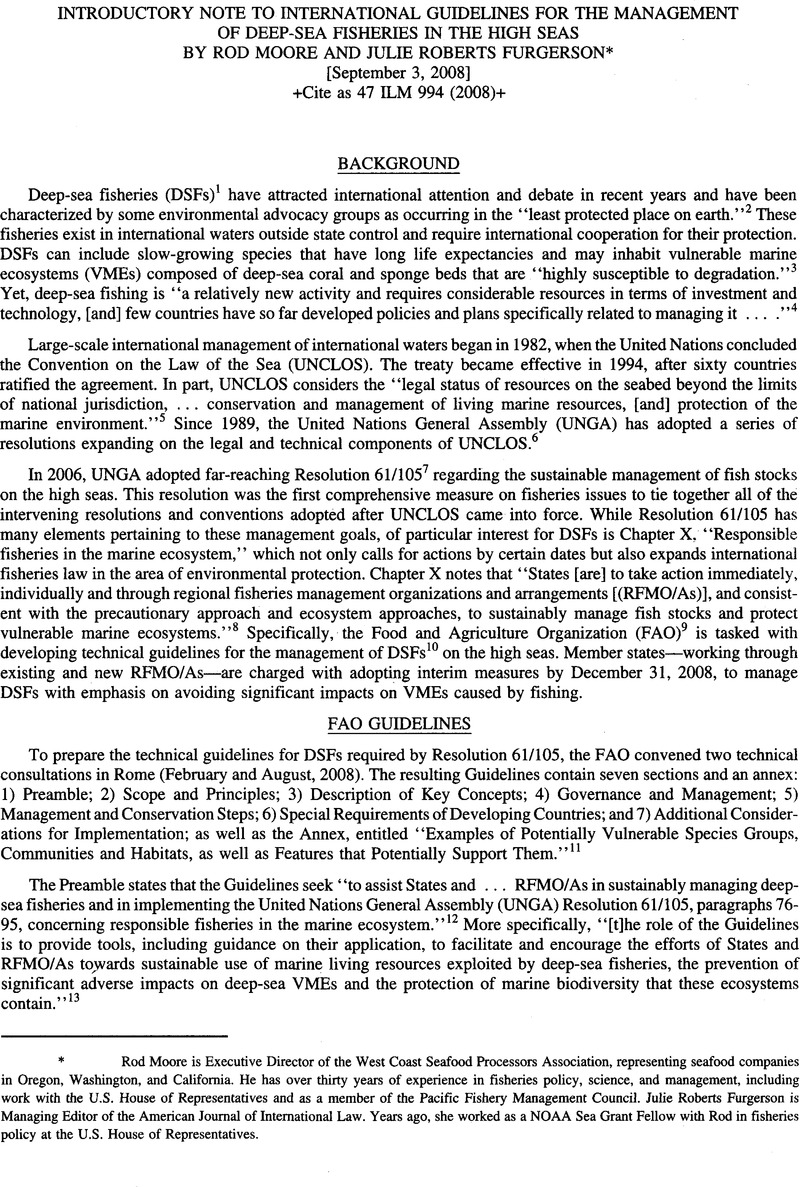Article contents
United Nations Food and Agriculture Organization: International Guidelines On Deep Sea Fisheries
Published online by Cambridge University Press: 27 February 2017
Abstract

- Type
- Case Report
- Information
- Copyright
- Copyright © American Society of International Law 2008
References
Endnotes
* This text was reproduced and reformatted from the text appearing at the ILM Issuu Database: (October 8,2008)< http://issuu.com/i.l.m./docs/fao_deep_sea_guidelines_final>
page 996 note 1 According to the Guidelines, deep sea fisheries (DSFs) are fisheries ‘ ‘occurring] in areas beyond national jurisdiction'’ and therefore require international cooperation for their management. Guidelines, § 2,¶ 8. DSFs have the following characteristics: “the total catch (everything brought up by the gear) includes species that can only sustain low exploitation rates; and the fishing gear is likely to contact the seafloor during the normal course of fishing operations.” Id. Although unspecified in the Guidelines, the continental shelf is considered to be located about 200 meters below the water surface, and DSFs are typically those occurring below the continental shelf (i.e., below the 200m mark).
page 996 note 2 Press Release, SeaWeb & Compass, The Last Wild Hunt— Deep-Sea Fisheries Scrape Bottom of the Sea (Feb. 17,2007), available at http://www.feru.org/news/2007%20News/ HSBT_seaweb.htm; see also Ichiro Nomura, FAO Assistant-Director General, Fisheries Department, 2004 FAO Fisheries Report No. 753, Appendix D.
page 996 note 3 Guidelines, § 5,¶ 42(iii).
page 996 note 4 Press Release, Food and Agricultural Organization of the United Nations, Better Management for Fishing's ‘Last Frontier’ (Sept. 3, 2008), http://www.fao.org/newsroom/en/news/ 2008/1000916/index.html.
page 996 note 5 United Nations Convention on the Law of the Sea of 10 December 1982, Historical Perspective, at http://www.un.org/ Depts/los/convention_agreements/convention_historical_ perspective.htm.
page 996 note 6 See G.A. Res. 44/225, U.N. Doc. A/RES/44/225 (Dec. 12, 1989); G.A. Res. 49/118, U.N. Dec. A/RES. 49/118 (Dec. 19, 1994).
page 996 note 7 G.A. Res. 61/105, U.N. Doc. A/RES/61/105 (Dec. 8, 2006).
page 996 note 8 Id. ¶ 80.
page 996 note 9 The FAO was chartered in 1945 as a permanent specialized United Nations agency for food and agriculture. For further background on the FAO, see http://www.fao.org.
page 996 note 10 The specific interest of UNCLOS in DSFs has developed due to the increasing pressure on fisheries resources the deep seas. “From 1950 to 1977, DSF represented less than 1 percent of the entire maritime catch. In the period between 1995 and 2005 the percentage grew to nearly 3 per cent and in 2005 it represented 4 per cent of the total maritime catch … .[Thus] [t]he DSF total catch increased by nearly 75 percent.” Analia Murias, Fao Focuses on Improving Deep Sea Fisheries Management, Fish info. & Servs., http://fis.com/fis/worldnews/woridnews.asp?l=e&ndb=l&id=27450. However, only limited international management of the DSFs occurred before the development of these Guidelines.
page 997 note 11 Guidelines, Table of Contents.
page 997 note 12 Guidelines, § 1,¶ 1.
page 997 note 13 Id. ¶ 6.
page 997 note 14 Guidelines, § 2, ¶ 8.
page 997 note 15 Id.
page 997 note 16 Guidelines, § 2, ¶12.
page 997 note 17 Guidelines, § 3, ¶ 13.
page 997 note 18 Id.
page 997 note 19 Id.
page 997 note 20 Bottom trawling refers to fishing with a fish net along the ocean floor. See Description of Fishing Gears Used on the U.S. West Coast, Pacific Fishery Management Council, Dec. 3,2003, at http://www.pcouncil.org/habitat/habrisk/apdx8.pdf
page 997 note 21 See id.
page 997 note 22 The Guidelines list six factors for defining the scale and significance of an impact: i. the intensity of severity of the impact at the specific site being affected; ii. the spatial extent of the impact relative to the availability of the habitat type affected; iii. the sensitivity/vulnerability of the ecosystem to the impact; iv. the ability of an ecosystem to recover from harm, and the rate of such recovery; v. the extent to which ecosystem functions may be altered by the impact; and vi. the timing and duration of the impact relative to the period in which a species needs the habitat during one or more of its life-history stages. Guidelines, § 3,¶ 18.
page 997 note 23 Guidelines, § 3,¶ 20
page 997 note 24 Guidelines, § 4,¶ 21.
page 997 note 25 Guidelines, § 4,¶ 22.
page 997 note 26 Id ¶¶26-29.
page 997 note 27 Guidelines, § 5,¶¶ 32,40,42.
page 997 note 28 Id¶47.
page 997 note 29 Id ¶¶-55-57.
page 997 note 30 Id ¶58.
page 997 note 31 Id¶60
page 997 note 32 Guidelines, § 5,¶ 76.
page 997 note 33 Guidelines, § 6,¶ 84.
page 997 note 34 Id ¶ 85.
page 997 note 35 Guidelines, § 7,¶ 86
page 997 note 36 Id ¶87.
page 997 note 37 Id ¶88.
page 997 note 38 Guidelines, Annex.
page 997 note 39 Id.
page 1009 note 1 Annex F of the Report of the Technical Consultation on International Guidelines for the Management of Deep sea Fisheries in the High Seas. Rome, 4-8 February and 25-29 August 2008.
page 1009 note 2 References in these guidelines to the 1982 UN Convention, the 1995 UN Fish Stocks Agreement and other international treaties do not prejudice the position of any State with respect to signature, ratification or accession to those instruments.
- 1
- Cited by




